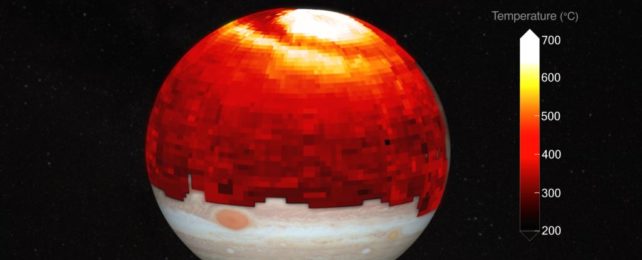A heatwave the size of 10 Earths has been discovered rippling through Jupiter's atmosphere.
It was 130,000 kilometers (around 81,000 miles) across, and a scorching 700 degrees Celsius (1,292 degrees Fahrenheit), traveling at speeds up to 2,400 meters per second away from the Jovian north pole.
And this, scientists say, could resolve one of the more perplexing mysteries about our Solar System's biggest planet – why it's so much hotter than models predict.
It's the permanent auroras that glimmer at Jupiter's poles that could be providing the extra energy to heat the gas giant to temperatures way beyond what we expect – and likely, along with a dense solar wind, responsible for the billowing heatwave.
"Last year we produced … the first maps of Jupiter's upper atmosphere capable of identifying the dominant heat sources," says astronomer James O'Donoghue of the Japan Aerospace Exploration Agency (JAXA) in Japan.
"Thanks to these maps, we demonstrated that Jupiter's auroras were a possible mechanism that could explain these temperatures."
The first inkling that there was something hinky going on in Jupiter's atmosphere came in the 1970s, around 50 years ago.
Jupiter is much farther from the Sun than Earth; roughly five times the distance, in fact. At that distance, it receives just four percent of the solar radiation that reaches Earth.
Its upper atmosphere should have an average temperature of around -73 degrees Celsius (-99 degrees Fahrenheit). Instead, it sits at around 420 degrees Celsius – comparable to Earth's upper atmosphere, and way higher than can be accounted for by solar heating alone.
This means that there must be something else going on at Jupiter, and the first heat maps, obtained by O'Donoghue and his colleagues and published last year, pointed to a solution.
Jupiter is crowned by the most powerful auroras in the Solar System, blazing in wavelengths invisible to the human eye. We also know that auroras here on Earth cause not-insignificant heating of our own atmosphere.
Jupiter's auroras form a lot like Earth's: an interaction between charged particles, magnetic fields, and molecules in the planet's atmosphere. And they're also very alien, too. Earth's auroras are born from gusts of particles blown in on powerful solar winds. They're sporadic, reliant on that irregular input.
Jupiter's auroras are permanent, generated by particles from its moon Io, the most volcanic object in the Solar System, which is constantly belching sulfur dioxide. This forms a torus of plasma around Jupiter, which is channeled to its poles via magnetic field lines, where it rains into the atmosphere.
Et voilà – aurora. The prior heat maps of Jupiter revealed hotspots directly below the auroral oval, suggesting a connection between the two.
But then it got more interesting. The contribution of Io doesn't mean that there is no auroral contribution from the Sun, and this is what O'Donoghue and his colleagues observed.
As they were collecting observations of Jupiter and its strange temperatures, a dense solar wind slammed into the gas giant. As a result, the team observed an enhancement to the auroral heating.
Because hot gas expands, this is probably what sent the heat wave spilling out of the auroral oval and rolling down towards the equator at speeds up to thousands of kilometers per hour.
So, as it propagated, this would have delivered a significant amount of additional heat to the Jovian atmosphere.
"While the auroras continuously deliver heat to the rest of the planet, these heat wave 'events' represent an additional, significant energy source," O'Donoghue explains.
"These findings add to our knowledge of Jupiter's upper-atmospheric weather and climate, and are a great help in trying to solve the 'energy crisis' problem that plagues research into the giant planets."
Jupiter is not the only planet in the Solar System that is hotter than it should be. Saturn, Neptune, and Uranus are all hundreds of degrees hotter than solar heating can account for.
While none of the others have auroras on the scale of Jupiter's, this finding represents an avenue for exploration that may go some way towards solving the puzzle.
The team presented their findings at the Europlanet Science Congress 2022.
